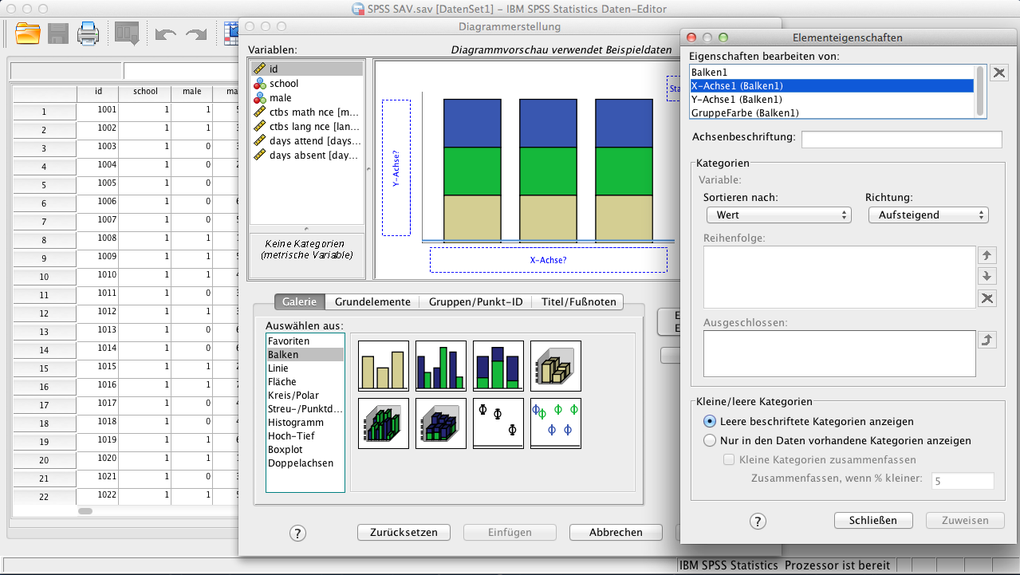

This is more of a study design issue than something you can test for, but it is an important assumption of the one-way ANOVA. For example, there must be different participants in each group with no participant being in more than one group. Assumption #3: You should have independence of observations, which means that there is no relationship between the observations in each group or between the groups themselves.

Example independent variables that meet this criterion include ethnicity (e.g., 3 groups: Caucasian, African American and Hispanic), physical activity level (e.g., 4 groups: sedentary, low, moderate and high), profession (e.g., 5 groups: surgeon, doctor, nurse, dentist, therapist), and so forth. Typically, a one-way ANOVA is used when you have three or more categorical, independent groups, but it can be used for just two groups (but an independent-samples t-test is more commonly used for two groups).

Assumption #2: Your independent variable should consist of two or more categorical, independent groups.You can learn more about interval and ratio variables in our article: Types of Variable. Examples of variables that meet this criterion include revision time (measured in hours), intelligence (measured using IQ score), exam performance (measured from 0 to 100), weight (measured in kg), and so forth. Assumption #1: Your dependent variable should be measured at the interval or ratio level (i.e., they are continuous).First, let’s take a look at these six assumptions: Even when your data fails certain assumptions, there is often a solution to overcome this.
Spss 22 fix pack how to#
This is not uncommon when working with real-world data rather than textbook examples, which often only show you how to carry out a one-way ANOVA when everything goes well! However, don’t worry. In practice, checking for these six assumptions just adds a little bit more time to your analysis, requiring you to click a few more buttons in SPSS Statistics when performing your analysis, as well as think a little bit more about your data, but it is not a difficult task.īefore we introduce you to these six assumptions, do not be surprised if, when analysing your own data using SPSS Statistics, one or more of these assumptions is violated (i.e., is not met). You need to do this because it is only appropriate to use a one-way ANOVA if your data "passes" six assumptions that are required for a one-way ANOVA to give you a valid result. When you choose to analyse your data using a one-way ANOVA, part of the process involves checking to make sure that the data you want to analyse can actually be analysed using a one-way ANOVA. However, before we introduce you to this procedure, you need to understand the different assumptions that your data must meet in order for a one-way ANOVA to give you a valid result. Since the one-way ANOVA is often followed up with a post hoc test, we also show you how to carry out a post hoc test using SPSS Statistics. This "quick start" guide shows you how to carry out a one-way ANOVA using SPSS Statistics, as well as interpret and report the results from this test. Alternatively, if your dependent variable is the time until an event happens, you might need to run a Kaplan-Meier analysis. To learn more, see our SPSS Statistics guide on ANCOVA. Note: If your study design not only involves one dependent variable and one independent variable, but also a third variable (known as a "covariate") that you want to "statistically control", you may need to perform an ANCOVA (analysis of covariance), which can be thought of as an extension of the one-way ANOVA. You can do this using a post hoc test (N.B., we discuss post hoc tests later in this guide). Since you may have three, four, five or more groups in your study design, determining which of these groups differ from each other is important. Also, it is important to realize that the one-way ANOVA is an omnibus test statistic and cannot tell you which specific groups were statistically significantly different from each other it only tells you that at least two groups were different. For example, you could use a one-way ANOVA to understand whether exam performance differed based on test anxiety levels amongst students, dividing students into three independent groups (e.g., low, medium and high-stressed students). The one-way analysis of variance (ANOVA) is used to determine whether there are any statistically significant differences between the means of two or more independent (unrelated) groups (although you tend to only see it used when there are a minimum of three, rather than two groups). One-way ANOVA in SPSS Statistics Introduction


 0 kommentar(er)
0 kommentar(er)
